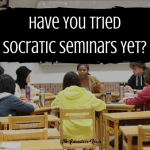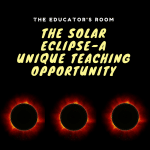An Interview With the Editor of Conjuring Worlds
Have you signed up for The Educator’s Room Daily Newsletter? Click here and support independent journalism!
Afrofuturism is highly-desired, but frequently a missing puzzle piece in many English Language Arts curriculums. B. Sharise Moore, a veteran educator and author of Dr. Marvellus Djinn’s Odd Scholars, hopes to change this with her new Afrofuturist textbook, Conjuring Worlds
I had the opportunity to talk with Moore about what inspired Conjuring Worlds and the process of putting together the first ever Afrofuturist textbook.
The Educator’s Room: Tell the readers of The Educator’s Room a little about yourself. What is your background in education?
Moore: My name is B. Sharise Moore, and I have been a classroom educator for 13 years. I’ve taught in public schools throughout Maryland as well as a homeschool collective. I have a Bachelor of Arts in English and my concentration was creative writing. I took about six different creative writing classes with my undergraduate degree. And six more creative writing classes for my Master’s in Curriculum and Instruction which has a focus in writing for children and young adults.
TER: What is the Afrofuturist textbook Conjuring Worlds?
Moore: Conjuring Worlds is an Afrofuturist textbook for middle and high school students. It’s over 400 pages including 30-plus pieces consisting of short stories, poems, essays, and artwork. There are 22 rubrics for parents and teachers to use to grade student work. There’s a glossary of 350-plus terms. There’s an interview section called “Innovation Interview Series” featuring interviews from people in publishing, a Hollywood writer, and a historian who discuss how their careers intersect with Afrofuturism.
Although Conjuring Worlds’ foundation is literature, it is interdisciplinary in nature. We’ve designed 150-plus extension activities. For example, students are asked to create infographics, design science projects and to visit restaurants and come up with their own menus. They’re asked to draw, to write skits, act out commercials, and more.
Conjuring Worlds is also Afrofuturistic in nature, and by that I mean it contains works written by Black people on the continent and throughout the diaspora. Afrofuturism is a way of seeing the world through the lens of Black people and is speculative in nature. Not only seeing us in the future thriving, but reimagining the past as well.
It’s taken a while to put everything together, but I’m really, really proud of the final product.
TER: What are you most excited for students and educators to gain from their experience working with Conjuring Worlds?
Moore: I’m excited about the extension activities. Each poem, piece of artwork, short story, and nonfiction entry has four to five activities along with discussion questions, comprehension questions, and vocabulary. It’s chock full of lots of activities that students will find enriching. I hope they won’t say to themselves “this is dumb” or “this is useless.” We’ve developed work and created questions that connect with their daily lives and that are relevant and enjoyable.
I’ve actually piloted a lot of the activities with the homeschool collective where I teach. For the last few months I’ve asked students to read some of the short stories and complete a few of the projects. And the response has been really, really good!

TER: What was the process like for Conjuring Worlds coming together?
Moore: It’s been 10 years in the making. I came up with the idea in 2012 when I started my graduate program. I wanted to create something that hasn’t been done. Original stories were what I wanted meaning that I’d have to build Conjuring Worlds from the ground up. And I knew it couldn’t be on that scale with thousands of dollars spent and teams of dozens of people. It needed to be manageable. So I thought, “Ok, if I can get maybe 30-35 entries of art, poetry, short stories, and nonfiction, then this could be a cool little textbook.”
From there I started to think about how much I wanted to pay my writers. Writers should always, always be paid. Working with my life coach at the time, we developed a budget and launched an Indiegogo campaign. I raised the funds thanks to so many amazing people, especially Audrey Williams, a speculative fiction writer and poet. She blasted my campaign on Twitter and to her contacts and it really blew up. After the funding, the next question was, “Who would be willing to be a part of this project?” I thought about all the amazing authors that I’ve befriended as the poetry editor of the award-winning Fiyah Literary Magazine. So I literally just asked folks, and everyone said “Of course, I would be honored.”
But I wanted to do something different too. I thought it would be thrilling for budding writers to have their work studied by other students. At the time I taught an online summer class and held a competition. A ten year old girl from Oakland, California submitted the best story. And now her story is in Conjuring Worlds. A rising first year college student wrote an interesting speculative poem, and I included her poem as well.
In the end, a very, very small crew ended up putting Conjuring Worlds together. My husband, a graphic designer, laid it out. Helena Hartsfield, an educator who I deeply respect, helped create the discussion questions. We did it piece by piece, developing the extension activities and discussion questions using Bloom’s Taxonomy and Gardner’s Multiple Intelligences. It’s been a heck of an experience, and I’m ready for it to be out in the world.
TER: Why is it important that Afrofuturist texts are a part of the curriculum?
Moore: It’s important because there are a breadth of stories that aren’t being told. It’s a way to show wonder and creativity in a way I don’t believe that realistic fiction can. Don’t get me wrong I love all fiction, but there’s something about the speculative fiction, which Afrofuturism falls under that umbrella, that creates characters, plot points, and settings that are out of this world amazing. Our students don’t often see characters of color set in those stories. It’s another door to open in a student’s mind that may not have opened before.
TER: Is there anything that you would like educators to know?
Moore: I want educators to know that even if you are unable to experience the freedom that you want, it exists in the texts we choose. I encourage teachers to join curriculum committees, write curriculum, and fight for books that they read, love, and believe children will enjoy. We’re the thought leaders. It’s important that we know we have power. The building of our classroom libraries is a powerful thing. I brought many students onboard to reading by introducing them to the right book.
Thank you to author and educator, B. Sharise Moore. To learn more about Conjuring Worlds or to purchase your own copy, you can go here.
Editor’s Note: If you enjoyed this article, please become a Patreon supporter by clicking here.







